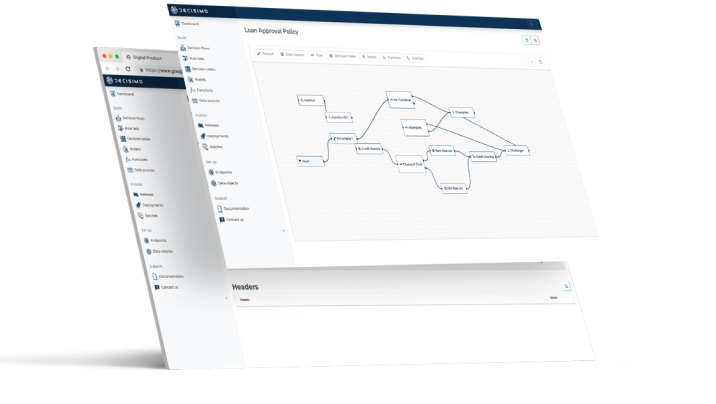5 Essential Components of Rule Engine Architecture - Decisimo - Decision Intelligence Services
Published on: 2024-08-10 18:36:09
The architecture of rule engines is a pivotal aspect of modern decision-making systems, especially in the era of cloud computing. As businesses increasingly rely on automated processes for efficiency and accuracy, understanding the intricacies of rule engine architecture becomes crucial.
Overview of Rule Engine Architecture
Rule engines are sophisticated systems essential for automated decision-making, characterized by their versatility and efficiency in various applications. Key components of rule engine architecture include:
- Rule Repository: The central hub for storing and managing decision logic.
- User Interface for Rule Management: Tools for creating, modifying, and overseeing rules.
- User Interface for Rule Deployment: Mechanisms for releasing and implementing rule changes.
- Rule Execution: The process that applies rules to data for decision-making.
- Historical Versioning and Accessibility: Maintaining a comprehensive history of all rule versions and changes for easy review and management.
These components, especially when hosted on cloud platforms, contribute to the adaptability and efficiency that make rule engines invaluable in a wide range of industries, from data validation to complex decision processes.
Rule Repository: The Core of Rule Engines
Designing an Effective Rule Repository
The rule repository, serving as the central hub of decision logic, is crucial for the functionality of a rule engine. An effective repository should:
- Store not only the current rules but also maintain a comprehensive history of all versions.
- Provide an easy way to access and review previous versions of rules, along with details about changes and the users who made them.
- Ensure seamless scalability and robustness, which is a standout feature of cloud-based systems.
These features not only enhance the repository's functionality but also add a layer of transparency and control, vital for complex decision-making environments.
Best Practices for Rule Repository Management
Managing a rule repository effectively is about more than just keeping it up-to-date. It involves:
- Regular audits and performance evaluations to ensure the repository remains efficient and effective.
- Implementing a system that supports quick and easy modifications, vital for dynamic decision environments.
- Integrating tools within the user interface that allow for effortless management of the rule repository, reducing the reliance on technical expertise.
Cloud-based solutions excel in these areas, offering advanced tools that simplify rule management while ensuring the system remains flexible and responsive to changes.
User Interface for Rule Management
Key Features of Rule Management Interfaces
Creating an effective user interface for rule management goes beyond mere functionality. It's about crafting an experience that is both intuitive and powerful. The ideal interface should:
- Enable users to create, modify, and delete rules with ease, without requiring advanced programming skills.
- Offer a straightforward, logical layout that simplifies complex decision-making processes.
- Balance simplicity in design with the complexity of the tasks it aims to accomplish.
Cloud-based interfaces are often at the forefront of this, providing more intuitive and accessible platforms. They help in reducing the learning curve, making rule management more efficient and less intimidating.
Enhancing Usability in Rule Management Systems
Enhancing usability in rule management systems is about removing the barriers of complexity while preserving the full spectrum of functionalities. A great UI/UX in rule engines achieves this by:
- Democratizing the rule management process, making it accessible to users with varying levels of technical expertise.
- Utilizing visual elements effectively to represent complex logic in a more digestible format.
- Ensuring that the interface is adaptable to different user needs and preferences, providing a personalized experience.
These aspects are particularly well-addressed in cloud-based systems, where the emphasis is on making powerful technology accessible and user-friendly, without limiting the capabilities and potential applications of the rule engine.
Deploying and Releasing New Rules: A User's Guide
Streamlining Rule Deployment Processes
The deployment of new rules should be a smooth process, minimizing disruptions to operations. Cloud-based rule engines shine here, offering seamless integration and deployment capabilities. Their ability to quickly propagate changes across systems without requiring downtime is a significant advantage over traditional, locally hosted solutions.
Ensuring Consistency and Efficiency in Rule Release
Consistency in deploying new rules is crucial to maintain system integrity and performance. Cloud-based engines provide a centralized framework that ensures uniformity in rule application across all nodes, a challenging feat in traditional setups.
Rule Execution: The Operational Backbone
Optimizing Rule Execution for Performance
Rule execution is where the decision-making happens, and its efficiency directly impacts the performance of the system. Cloud-based engines, with their scalable infrastructure, can handle varying loads efficiently, ensuring high performance even under heavy demand.
Troubleshooting Common Rule Execution Issues
Troubleshooting in cloud-based systems is often more straightforward, thanks to advanced monitoring tools and support structures. This ease of maintenance ensures that issues are resolved swiftly, reducing downtime and enhancing reliability.
Future Trends in Rule Engine Architecture
Emerging Technologies and Their Impact
The integration of AI and machine learning into cloud-based rule engines is setting a new standard for decision-making systems. These advancements include:
- Unprecedented levels of automation and intelligence.
- Increased adaptability and insightfulness of rule engines.
- Direct usage of ML models within the decision flow, utilizing languages like Python, R, and Julia.
- Implementation of LLM (Large Language Model)-based copilots for assistance in building decision logic, setting up, and validating rules.
This integration is making rule engines more adaptable and insightful, capable of handling complex decision processes with greater efficiency and accuracy.
Preparing for Scalable and Flexible Architectures
The future of rule engine architecture lies in its scalability and flexibility, areas where cloud-based solutions inherently excel. As organizations grow and their needs evolve, these systems can adapt swiftly, underscoring the advantage of cloud-based architectures over traditional, code-intensive setups.


